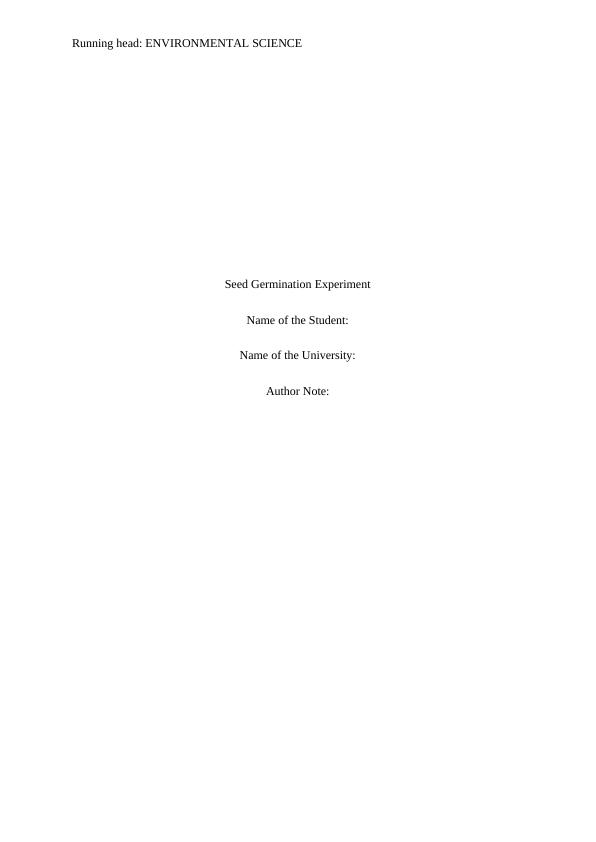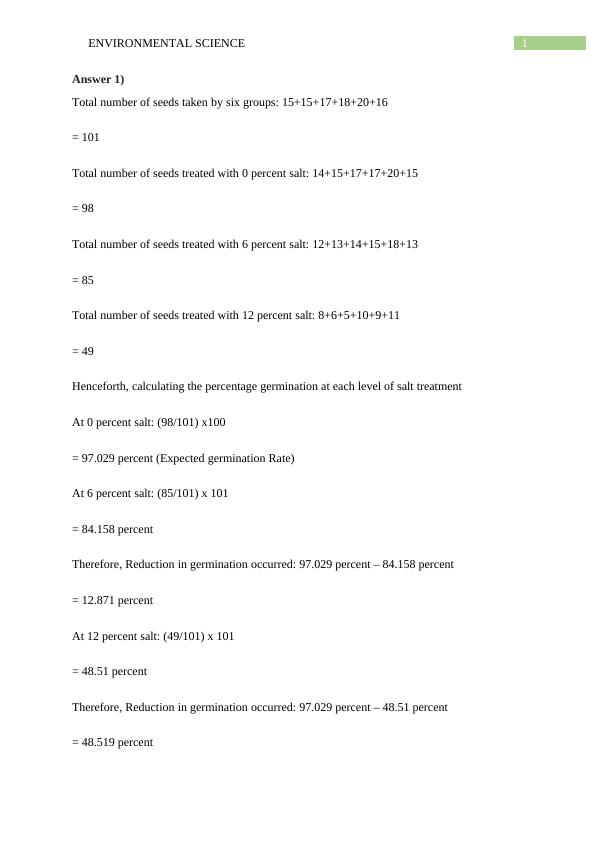Seed Germination Experiment
9 Pages1854 Words13 Views
Added on 2022-08-17
Seed Germination Experiment
Added on 2022-08-17
ShareRelated Documents
Running head: ENVIRONMENTAL SCIENCE
Seed Germination Experiment
Name of the Student:
Name of the University:
Author Note:
Seed Germination Experiment
Name of the Student:
Name of the University:
Author Note:

1ENVIRONMENTAL SCIENCE
Answer 1)
Total number of seeds taken by six groups: 15+15+17+18+20+16
= 101
Total number of seeds treated with 0 percent salt: 14+15+17+17+20+15
= 98
Total number of seeds treated with 6 percent salt: 12+13+14+15+18+13
= 85
Total number of seeds treated with 12 percent salt: 8+6+5+10+9+11
= 49
Henceforth, calculating the percentage germination at each level of salt treatment
At 0 percent salt: (98/101) x100
= 97.029 percent (Expected germination Rate)
At 6 percent salt: (85/101) x 101
= 84.158 percent
Therefore, Reduction in germination occurred: 97.029 percent – 84.158 percent
= 12.871 percent
At 12 percent salt: (49/101) x 101
= 48.51 percent
Therefore, Reduction in germination occurred: 97.029 percent – 48.51 percent
= 48.519 percent
Answer 1)
Total number of seeds taken by six groups: 15+15+17+18+20+16
= 101
Total number of seeds treated with 0 percent salt: 14+15+17+17+20+15
= 98
Total number of seeds treated with 6 percent salt: 12+13+14+15+18+13
= 85
Total number of seeds treated with 12 percent salt: 8+6+5+10+9+11
= 49
Henceforth, calculating the percentage germination at each level of salt treatment
At 0 percent salt: (98/101) x100
= 97.029 percent (Expected germination Rate)
At 6 percent salt: (85/101) x 101
= 84.158 percent
Therefore, Reduction in germination occurred: 97.029 percent – 84.158 percent
= 12.871 percent
At 12 percent salt: (49/101) x 101
= 48.51 percent
Therefore, Reduction in germination occurred: 97.029 percent – 48.51 percent
= 48.519 percent

2ENVIRONMENTAL SCIENCE
Answer 2)
The treatment with 12 percent salt shows the most impact on germination of the
seeds. Overall, the germination reduction counted after 12 percent salt treatment was
approximately 49 percent, which was a relatively high rate of reduction in seed germination
due to salt intolerance.
Answer 3)
Road salt effecting vegetation
As roots and foil are exposed to salt-laden water, plants become injured. As salt water
sprays from the ground from moving vehicles, the vegetaition is harmed from the roadside
veichel movement. Saltwater loaded by the soil profile can also percolate, and come into
contact with particulates of soil, soil microbes and plant roots. Foliage destruction by salt:
Air tension increases. Throughout the root zone, salt ions retain air molecules very
tightly, rendering it impossible to extract sufficiently water from roots. Sensitive plants may
result throughout reduced growth and yield from it "physiological drought."
The soil quality is affected. In rock salt, the sodium ion portion is linked to soil particles
and transfers soil components such as potassium and phosphorus. It contributes to decreased
soil density and compaction, and diminished runoff and aeration. Furthermore, chloride and
calcium can be used to activate heavy metals. Under these conditions, plant growth and vigor
are poor.
Accumulation to plant toxicity. Root and leaf absorbs the chloride component of salt and
is focused on active tissue. Repeatedly exposed plants can accumulate chloride ions for long
periods of time in toxic levels, leading to the burning of leaves and twigs.
Answer 2)
The treatment with 12 percent salt shows the most impact on germination of the
seeds. Overall, the germination reduction counted after 12 percent salt treatment was
approximately 49 percent, which was a relatively high rate of reduction in seed germination
due to salt intolerance.
Answer 3)
Road salt effecting vegetation
As roots and foil are exposed to salt-laden water, plants become injured. As salt water
sprays from the ground from moving vehicles, the vegetaition is harmed from the roadside
veichel movement. Saltwater loaded by the soil profile can also percolate, and come into
contact with particulates of soil, soil microbes and plant roots. Foliage destruction by salt:
Air tension increases. Throughout the root zone, salt ions retain air molecules very
tightly, rendering it impossible to extract sufficiently water from roots. Sensitive plants may
result throughout reduced growth and yield from it "physiological drought."
The soil quality is affected. In rock salt, the sodium ion portion is linked to soil particles
and transfers soil components such as potassium and phosphorus. It contributes to decreased
soil density and compaction, and diminished runoff and aeration. Furthermore, chloride and
calcium can be used to activate heavy metals. Under these conditions, plant growth and vigor
are poor.
Accumulation to plant toxicity. Root and leaf absorbs the chloride component of salt and
is focused on active tissue. Repeatedly exposed plants can accumulate chloride ions for long
periods of time in toxic levels, leading to the burning of leaves and twigs.

End of preview
Want to access all the pages? Upload your documents or become a member.
